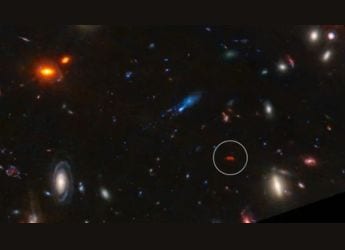- Home
- Science
- Science News
- Extreme Star Factory: ALMA Detects Galaxy Y1 Forming Stars 180 Times Faster Than the Milky Way
Extreme Star Factory: ALMA Detects Galaxy Y1 Forming Stars 180 Times Faster Than the Milky Way
The discovery highlights intense, hidden starbursts that shaped early galaxies less than a billion years after the Big Bang.

Photo Credit: NASA, ESA, CSA, STScI, J. Diego (Instituto de Física de Cantabria, Spain)
The galaxy Y1, the circled red grain, as seen by the James Webb Space Telescope.
By measuring the temperature of a distant galaxy with the Atacama Large Millimeter/submillimeter Array (ALMA) telescope, astronomers have discovered an extreme star factory. The galaxy was Y1, and it lived between 600 and 800 million years after the Big Bang. The team headed by Tom Bakx of Chalmers University of Technology in Sweden discovered that Y1 is forming stars at approximately 180 solar masses per year, which is approximately 180 times the rate at which the Milky Way forms its stars. This is one way that the galaxies have become this fast in the young universe.
A superheated star factory
According to the paper, using ALMA's Band 9 (0.44 mm) and its array of 66 radio antennas, the Chalmers-led team captured Y1's dust emission, finding it shining at ~90 K (~–180 °C). Astronomer Yoichi Tamura says this warm dust confirms Y1 as “an extreme star factory”. The galaxy's star-formation rate is over 180 M☉ per year (versus ~1 M☉ in the Milky Way) – an unsustainably intense burst. Y1 (also called MACS0416_Y1) lies at redshift ≈8.3. Such brief, hidden bursts may have been common in the early universe.
Starbursts across the early cosmos
This picture is supported by other observations. As an example, Webb images discovered approximately 83 small starburst galaxies at a time of 800 million years following the Big Bang. According to NASA, these are the galaxies that are tiny yet powerful enough to cause cosmic reionisation as observed by Isak Wold. Similarly, ALMA/JWST observations discovered a barred spiral (J0107a) that was approximately 10 times the Milky Way in mass, and was capable of forming stars at a rate of approximately 300x. These findings have the suggestion that the starbursts that were hidden were an essential part of the early universe.
Get your daily dose of tech news, reviews, and insights, in under 80 characters on Gadgets 360 Turbo. Connect with fellow tech lovers on our Forum. Follow us on X, Facebook, WhatsApp, Threads and Google News for instant updates. Catch all the action on our YouTube channel.
Related Stories
- Samsung Galaxy Unpacked 2025
- ChatGPT
- Redmi Note 14 Pro+
- iPhone 16
- Apple Vision Pro
- Oneplus 12
- OnePlus Nord CE 3 Lite 5G
- iPhone 13
- Xiaomi 14 Pro
- Oppo Find N3
- Tecno Spark Go (2023)
- Realme V30
- Best Phones Under 25000
- Samsung Galaxy S24 Series
- Cryptocurrency
- iQoo 12
- Samsung Galaxy S24 Ultra
- Giottus
- Samsung Galaxy Z Flip 5
- Apple 'Scary Fast'
- Housefull 5
- GoPro Hero 12 Black Review
- Invincible Season 2
- JioGlass
- HD Ready TV
- Laptop Under 50000
- Smartwatch Under 10000
- Latest Mobile Phones
- Compare Phones
- OPPO Reno 15 Pro
- OPPO Reno 15
- Vivo Y500 Pro
- Realme GT 8 Pro Aston Martin F1 Limited Edition
- Huawei Mate 70 Air
- Moto G57
- Moto G57 Power
- Motorola Edge 70
- Asus ProArt P16
- MacBook Pro 14-inch (M5, 2025)
- iQOO Pad 5e
- OPPO Pad 5
- Noise Diva 2
- Noise Halo 2
- Acerpure Nitro Z Series 100-inch QLED TV
- Samsung 43 Inch LED Ultra HD (4K) Smart TV (UA43UE81AFULXL)
- Asus ROG Ally
- Nintendo Switch Lite
- Haier 1.6 Ton 5 Star Inverter Split AC (HSU19G-MZAID5BN-INV)
- Haier 1.6 Ton 5 Star Inverter Split AC (HSU19G-MZAIM5BN-INV)

















